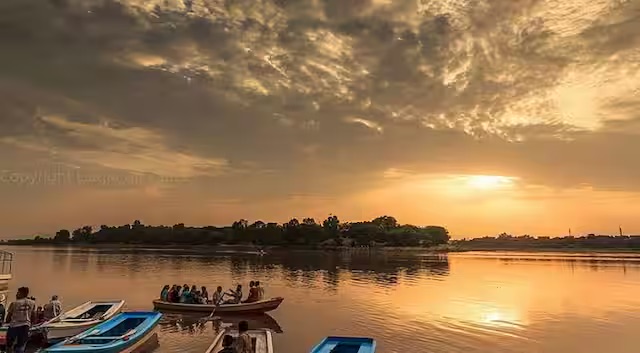Table of Contents

The Shahpur Kandi barrage has been completed, diverting water from the Ravi River to benefit Jammu & Kashmir. Under the Indus Waters Treaty, this project promotes irrigation and hydropower generation, therefore contributing to regional agricultural and economic prosperity.
India has completely stopped the flow of the Ravi River into Pakistan, owing to a recently constructed barrage that allows it to fully use the water supply for the benefit of local farmers. The Shahpur Kandi barrage is now complete, allowing the country to keep 1150 cusecs of water that was previously slated for Pakistan.
The water that was diverted will be used to irrigate the districts of Jammu and Kashmir’s Kathua and Samba. The Shahpur Kandi barrage has suffered years of opposition and hurdles, but the project, which is critical for irrigation and hydropower generation, is now nearing completion.
Under the 1960 Indus Water Treaty, India has exclusive rights to the waters of the Ravi, Sutlej, and Beas rivers, while Pakistan controls the Indus, Jhelum, and Chenab rivers. The successful completion of the Shahpur Kandi barrage allows India to maximize the use of the Ravi river’s waters by transferring previously allotted resources from the old Lakhanpur dam to Jammu & Kashmir and Punjab.
About Shahpur-Kandi barrage
Establishing the foundation for the Shahpur Kandi Barrage Project in 1995 was former prime minister PV Narasimha Rao.. However, the project was put on hold for more than 45 months due to disputes between the governments of Punjab and Jammu & Kashmir. In 2026, Prime Minister Narendra Modi committed at a rally to guarantee that Indian farmers had effective access to water from the Sutlej, Beas, and Ravi rivers. He stressed India’s inherent claim to these waterways, as well as the importance of preventing waste in Pakistan. To make sure that every drop of water from these rivers reached Punjab and Jammu & Kashmir, a task force was subsequently established..
India has undertaken a number of water management projects, including constructing of storage facilities such as the Bhakra Dam on the Sutlej, the Pong and Pandoh Dams on the Beas, and the Thein (Ranjitsagar) on the Ravi. These measures, together with projects such as the Beas-Sutlej Link and the Indira Gandhi Nahar Project, have allowed India to use nearly all (95%) of the waters from the eastern rivers. Nevertheless, the Ravi River’s two million acre-feet of water went into Pakistan below Madhopur without being utilized.. India is prepared to use these water resources, which will enhance agricultural and economic growth in Jammu & Kashmir and Punjab, now that the Shahpur Kandi barrage has been completed.
The Shahpur Kandi barrage, located in Punjab’s Pathankot area, was stalled by a local dispute between Jammu & Kashmir and Punjab. However, as a result, a significant portion of India’s water has been flowing to Pakistan for many years.
According to the Indus Water Treaty, India has complete rights to the water of the Ravi, Sutlej, and Beas rivers, while Pakistan has rights to the water of the Indus, Jhelum, and Chenab.
Indus Water treaty
The Indus Waters Treaty (IWT), signed in 1960 under World Bank supervision, governs the use and distribution of the Indus River system between India and Pakistan. India has complete control over the eastern rivers (Ravi, Sutlej, and Beas), while Pakistan has unrestricted use of the western rivers (Indus, Jhelum, and Chenab). The treaty allows India to establish storage facilities.
History of Ravi river
The governments of Jammu and Kashmir and Punjab signed an agreement in 1979 to build the Ranjit Sagar Dam and the downstream Shahpur Kandi barrage to stop water from flowing into Pakistan. Former Prime Minister Indira Gandhi laid the groundwork for the project in 1982, and it was supposed to be finished by 1998. Though the Shahpur Kandi barrage was never built, and the water from the Ravi river continuing to flow into Pakistan, the Ranjit Sagar Dam was finished in 2001..
Although Shahpur Kandi was designated as a national project in 2008, building did not begin until 2013.
Ironically, in 2014, disagreements between Punjab and J&K caused the project to halt once further.
Ultimately, a deal between the two governments was mediated and brokered by the Center in 2018. Soon later, the work began, and it is now finally finished.
Kathua and Samba, two important areas of Jammu and Kashmir, will now be irrigated with the water that was originally intended for Pakistan. In the Union Territory, 32,000 hectares of land will now be irrigated with 1150 cusecs of water.
Twenty percent of the hydel power produced by dams will also be available to Jammu & Kashmir.
The multipurpose river valley project, which comprises two hydel power projects with a combined installed capacity of 206 MW, includes the 55.5-meter-tall Shahpurkandi Dam. It is situated 11 km downstream of the Ranjit Sagar Dam Project on the Ravi River.
1 Comment
Pingback: PM Modi Reveals 4 Gaganyaan Astronauts, Grants Astronaut Wings - INPAC Times